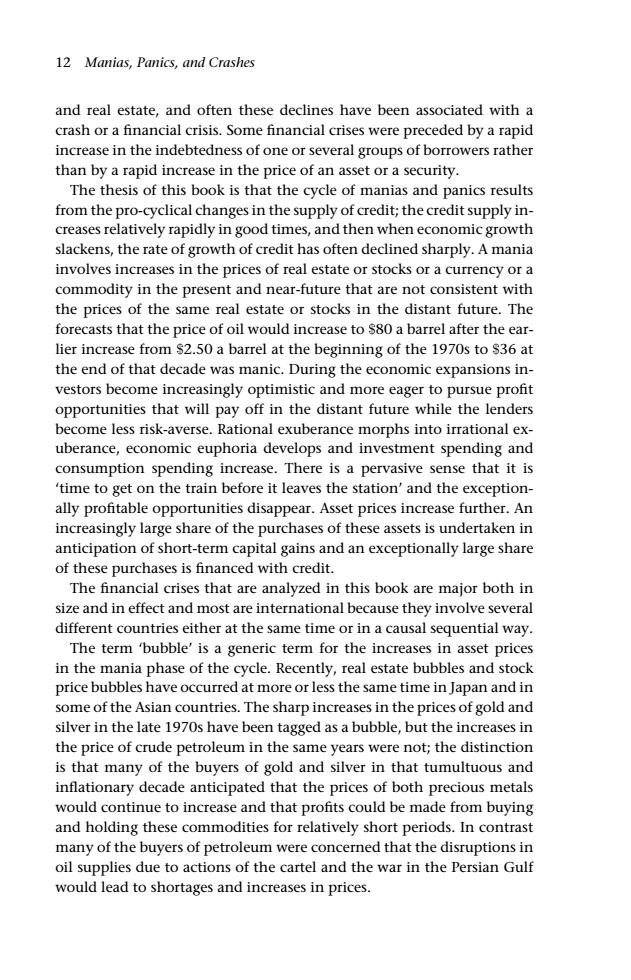正在加载图片...

12 Manias,Panics,and Crashes and real estate,and often these declines have been associated with a crash or a financial crisis.Some financial crises were preceded by a rapid increase in the indebtedness of one or several groups of borrowers rather than by a rapid increase in the price of an asset or a security. The thesis of this book is that the cycle of manias and panics results from the pro-cyclical changes in the supply of credit;the credit supply in- creases relatively rapidly in good times,and then when economic growth slackens,the rate of growth of credit has often declined sharply.A mania involves increases in the prices of real estate or stocks or a currency or a ommodity in the present and near-future that are not consistent with the prices of the same real estate or stocks in the distant future.The forecasts that the price of oil would increase to s80 a barrel after the ear- lier increase from $2.50 a barrel at the beginning of the 1970s to $36 at the end of that decade was manic.During the economic expansions in- vestors become increasingly optimistic and more eager to pursue profit opportunities that will pay off in the distant future while the lenders become less risk-averse.Rational exuberance morphs into irrational ex- uberance,economic euphoria develops and investment spending and consumption spending increase.There is a pervasive sense that it is 'time to get on the train before it leaves the station'and the exception- ally profitable opportunities disappear.Asset prices increase further.An increasingly large share of the purchases of these assets is undertaken in anticipation of short-term capital gains and an exceptionally large share of these purchases is financed with credit. The financial crises that are analyzed in this book are major both in size and in effect and most are international because they involve several different countries either at the same time or in a causal sequential way. The term bubble'is a generic term for the increases in asset prices in the mania phase of the cycle.Recently,real estate bubbles and stock price bubbles have occurred at more or less the same time in Japan and in ome of the Asian countries.The sharp increases in the prices of gold and silver in the late 1970s have been tagged as a bubble,but the increases in the price of crude petroleum in the same years were not;the distinction is that many of the buyers of gold and silver in that tumultuous and inflationary decade anticipated that the prices of both precious metals would continue to increase and that profits could be made from buying and holding these commodities for relatively short periods.In contrast many of the buyers of petroleum were concerned that the disruptions in oil supplies due to actions of the cartel and the war in the Persian Gulf would lead to shortages and increases in prices. c01 JWBK120/Kindleberger February 13, 2008 14:58 Char Count= 12 Manias, Panics, and Crashes and real estate, and often these declines have been associated with a crash or a financial crisis. Some financial crises were preceded by a rapid increase in the indebtedness of one or several groups of borrowers rather than by a rapid increase in the price of an asset or a security. The thesis of this book is that the cycle of manias and panics results from the pro-cyclical changes in the supply of credit; the credit supply increases relatively rapidly in good times, and then when economic growth slackens, the rate of growth of credit has often declined sharply. A mania involves increases in the prices of real estate or stocks or a currency or a commodity in the present and near-future that are not consistent with the prices of the same real estate or stocks in the distant future. The forecasts that the price of oil would increase to $80 a barrel after the earlier increase from $2.50 a barrel at the beginning of the 1970s to $36 at the end of that decade was manic. During the economic expansions investors become increasingly optimistic and more eager to pursue profit opportunities that will pay off in the distant future while the lenders become less risk-averse. Rational exuberance morphs into irrational exuberance, economic euphoria develops and investment spending and consumption spending increase. There is a pervasive sense that it is ‘time to get on the train before it leaves the station’ and the exceptionally profitable opportunities disappear. Asset prices increase further. An increasingly large share of the purchases of these assets is undertaken in anticipation of short-term capital gains and an exceptionally large share of these purchases is financed with credit. The financial crises that are analyzed in this book are major both in size and in effect and most are international because they involve several different countries either at the same time or in a causal sequential way. The term ‘bubble’ is a generic term for the increases in asset prices in the mania phase of the cycle. Recently, real estate bubbles and stock price bubbles have occurred at more or less the same time in Japan and in some of the Asian countries. The sharp increases in the prices of gold and silver in the late 1970s have been tagged as a bubble, but the increases in the price of crude petroleum in the same years were not; the distinction is that many of the buyers of gold and silver in that tumultuous and inflationary decade anticipated that the prices of both precious metals would continue to increase and that profits could be made from buying and holding these commodities for relatively short periods. In contrast many of the buyers of petroleum were concerned that the disruptions in oil supplies due to actions of the cartel and the war in the Persian Gulf would lead to shortages and increases in prices